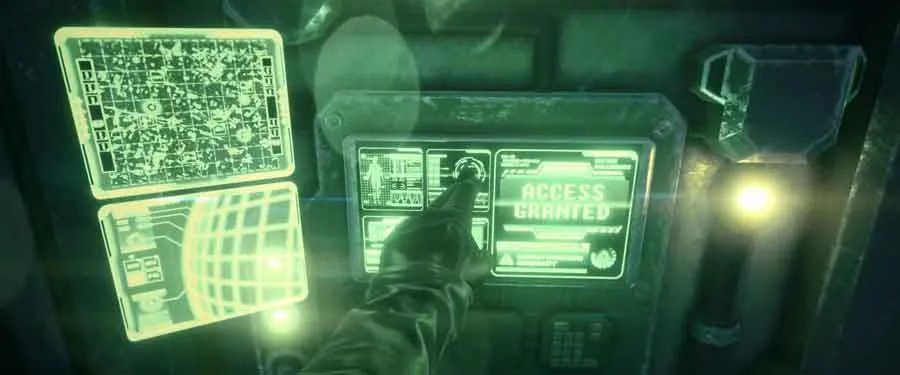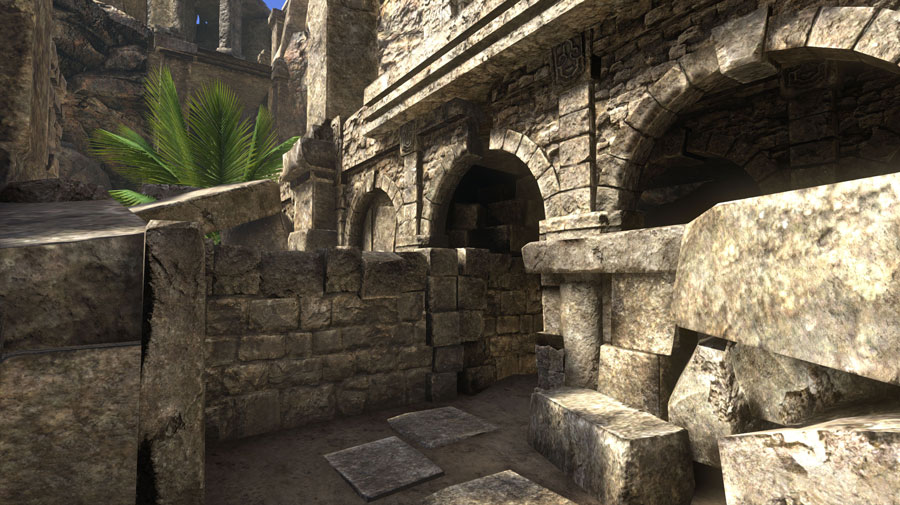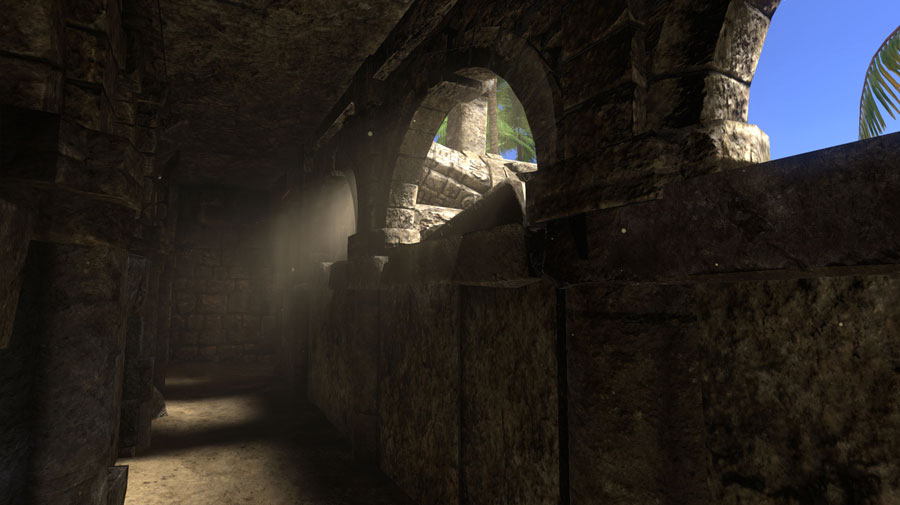The landscape around the building was incredibly unassuming as we pulled up to the industrial park’s parking lot.
“Are we in the right place?” I asked, turning to Taylor Freeman, one of my co-founders at UploadVR.
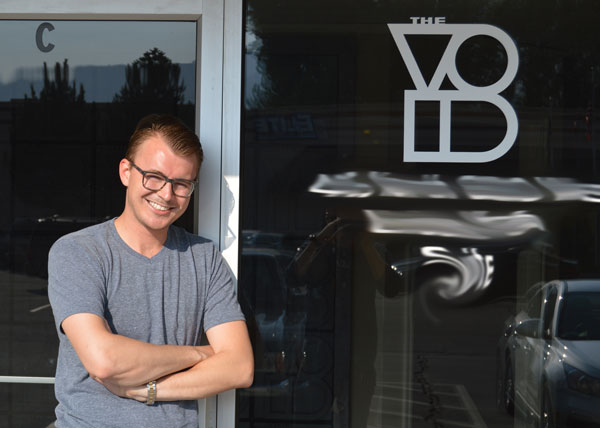
The building in front of us was about as unpretentious as it could possibly be, a far cry from what we had seen in the video. A single story concrete slab of small offices tucked behind another concrete slab of small offices, the modest setting punctuated by the dry mountainous terrain of Utah.
The navigation system interjected, “you have arrived.”
“I guess so,” said Taylor, smiling.
I scanned the plain concrete facades and the glass doors of the offices along the strip, looking for one that stood out. I didn’t find it, not at first. It took a good two minutes to locate the low-key white logo on the plain glass door, but as soon as I did I felt a familiar jolt of excitement, that jolt that comes when you instinctively know you are about experience something awesome.
I was about to enter The Void.
For those unfamiliar, The Void is an out of home virtual entertainment center that is making its mission to create the most immersive VR experiences possible, using advanced proprietary virtual reality technology and real world effects. Earlier in May, they released a YouTube video teasing the centers’ promising capabilities; which if you haven’t seen is well worth the watch.
The company’s founder and Chief Visionary Officer, James Jensen greeted us at the door. We both shook his hand as we gazed around the office, which was far less unassuming on the inside. Stone tiles engraved with The Void’s logo adorned the wall directly in front of the entrance. To our right was a lounge area positioned in front of the room to the experience itself (which requires an entire staging area). Above the couch in the lounge was another logo display, this one with animation playing in the negative space of the letters. The impressive interior juxtaposed against the modest exterior in a way that screamed stealthily-well-funded startup.
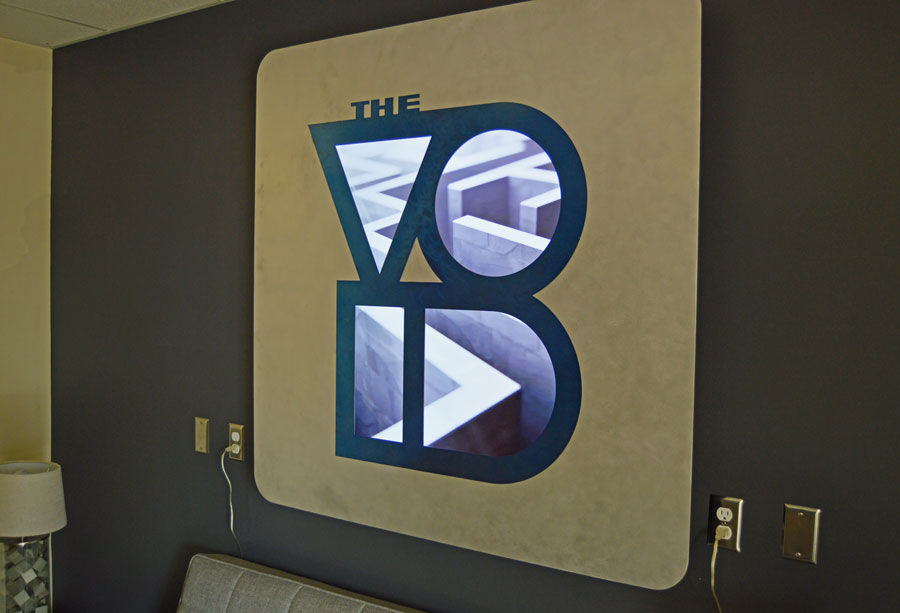
As Jensen led us into the conference room to chat he informed us that unfortunately we were unable to try the company’s proprietary setup, The Rapture, because it was not quite yet ready. However, we were able to get a peek at some of the pieces being built into the prototype. The headset itself will feature a unique dual curved screen design with a very intriguing dual aspheric, fresnel lens design which is aimed at providing a crisp view in the center of the gaze with the addition of peripheral vision. Jensen tells us that they are “shooting for 160° to 180° [FOV].”
The headset’s proposed design is also punctuated by something Jensen has dubbed, “the backtop.” The backtop refers to the back of the headset, wherein all of the key components and sensors are housed. This allows for a very lightweight and thin front shield design as well as a more balanced ergonomic feel. This innovation, Jensen believes, will be the future of HMDs. The Rapture also uses an incredibly novel tracking solution that is unlike any of the other solutions being utilized by the other headset manufacturers, but we will dive into that in a lot more depth in a separate piece.
After chatting with us for a while, Jensen led us towards the door to The Void, sparking up further conversation as we went.
“So when we were getting started on this project someone told me to pick up a copy of Ready Player One,” he said. “I thought it was pretty hilarious that the guy is also named James,” smiling as he opened the door to his own Oasis. The signs all over the wall made it clear that what was behind the doors in this room was secret, and I left my camera outside in the lounge area.
The room was fairly dark, aside from a few lights above the set, which we were told earlier was only about a fourth of the size of the full playfield. The area appeared to stretch back about forty feet and reminded me of a laser tag arena as I walked up the stairs.
At the top of the stairs was a starting zone. To the right was a touchpad embedded on the wall that displayed experiences and arena controls. This was the command center where every experience was launched and controlled. To the left were the temporary hardware setups, a DK2 with a Leap Motion mounted on the front, attached to a helmet with Optitrack marker balls plastered around it. Above us were tens of Optitrack motion capture cameras, The Void’s temporary tracking solution.
I slipped on the back pack computer, stood on one of the numbers on the floor before pulling the helmet over my head and slipping the DK2 over my eyes. I plunged into blackness.
“Ready player one,” I exhaled in anticipation, as Jensen laughed approvingly.
Step into The Void with us, continued on page 2
Entering The Mayan Tomb
Jensen begins the experience as a grey Void logo appears on the screen. The logo disappears as I find myself in a white room with light blue accents. The room doesn’t feel like it is any place in particular, but rather an aqueous, dare I say… void. After looking around for a moment and having my height calibrated by the system a female narrator’s voice comes over the comms in my headset. As she begins to speak a hole rips open in the wall behind me, revealing a portal into an ancient looking temple structure covered in jungle foliage. She tells me to step in, and I do; cautiously at first, before pushing myself through the portal completely. As I stepped into the other side, the white room vanished and I found myself standing by a wall outside of the temple, in the exact same location I had seen through the portal.
As I began to walk, I instinctively reached out to feel the wall next to me, and was taken aback for a moment when my hand actually touched solid wall. I continued to trace my hand along the wall as I walked forward, basking in the growing sense of Presence with each step.
I rounded the corner and found myself in a small clearing, with a door in distance to my left and beside it, a stone bench. The narrator beckons me to walk over and sit down on the bench. I do, first feeling out that it was there before sitting down. It was in this moment as the narrator told me that I was going to visit a Mayan tomb and look for treasure that I felt myself confidently slide into the scene, allowing my brain to fully be immersed in the illusion and feeling as comfortable (or uncomfortable) in walking around the tomb in VR as I would have in real life.
At this point, Jensen, who was following alongside me as I went through the experience, hands me a torch (which in the real world was actually a hacked PS Move controller with Optitrack markers). “Normally you would grab this off the wall,” he said, “but we haven’t mounted it yet.”
As the narration finished, I stood up and walked through the door to the ancient temple. In front of me was a long straight corridor and along the wall to my left were a number of crevices and holes in the wall. I tried peering into them and sticking my torch inside to get a better look but they revealed no secrets. I continued running my hand along the straight wall the whole time, or at least my brain thought it was straight.
Once I reached the end of the hall James interrupted the experience “I want you to turn around so I can show you something,” he interjected. I turned around and imagined him pointing as he said, “that long straight corridor you just walked down? That was actually a curved line.”
An Aside on Redirected Walking
The Void’s utilizes a technique known as redirected walking, which uses perceptual tricks to make your mind believe that you are walking in a straight line, even though you actually are being directed in a curve. You see, the brain is this funny thing. Try putting on a blindfold and walking in a straight line for more than 10 feet, I am willing to bet you will find that you curved either to the left or the right. The exact reasons for this are still up for debate but the main consensus is that it is an accumulation of errors in your brain’s ability to perceive ‘straight’ without visual cues. In this case the HMD acts as the blindfold, and experiences are able to feed visual nuances mapped exactly to the play space you are in, allowing for far more expansive, freely moving experiences in smaller spaces. Curtis Hickman, the company’s Chief Creative Officer and former real life magician devised the Void’s technique, which is the most effective and eloquent use of redirected walking I have had the pleasure of experiencing.
“I could have you running in a straight line for miles, but in reality you are running in circles,” says Curtis Hickman, the Void’s Chief Creative Officer.
I continued forward, turning right at the end of the corridor and twisting and turning my way through a number of short halls I found myself in a room with a fire burning inside. As I approached it the narrator came back on to speak about the flame, pointing out that it was strange that even though this place had been abandoned for years the fire was burning. After musing on this for a moment she encouraged me to walk up to it and feel it. As I did I felt the warmth of the flame against my virtual hand and I pulled back.
“That’s awesome,” I gleefully explained as I cusped my hands around the real life heat lamp for a moment of warmth.
Moving to my right I stepped outside, in front of me a grassy strip of temple leading to a rickety looking wood planked platform. To my left and below the platform the scene opened up to a waterfall cascading down in front of me. As I stared out at it I could actually feel the wind and mist hit my face washing me in a sense of total Presence.
The narrator’s voice came back again, instructing me to place my hand on the stone panel near the end of the platform. I walked over to it and did as I was told. My hand met a cold surface that rumbled and sunk as the panel grinded against the stone and into the ground. I felt the panel physically sink as well in the real world and saw it happen in the virtual one.
At the same time I felt a strong kick from the floor below me as the platform began to raise slowly shaking along the way. The level of presence in the moment was so complete that for the first time in my entire career trying VR I had to brace myself. My brain’s survival instinct would not let me move as I shifted into a position of balance. I have tried just about everything, including the famous plank floor demo at Stanford’s Human Interaction Lab (where the majority of people refuse to jump off the plank into the pit below), and never have I felt so legitimately Present in a scene.
The ride on the platform came to an end after about 15 seconds, and I relaxed again. There was a ledge in front of me that I peered over but I couldn’t quite get myself to step off the edge.
Stepping off the platform back onto the stone floor of the temple I continued forward on my quest through the temple, once again entering it’s winding corridors. After another short while I found myself in a room with a crumbling floor. Walking up to one of the holes in the floor I peered down into it, and saw a room far below. Again, I knew there wasn’t any real danger, but my brain still reacted to the simulation causing me to step back and carefully move through the crumbling floor skipping between the solid spots like a kid playing the hot lava game.
Reaching the end of that room finally I entered another with high ceilings, which immediately began crumbling around me. The whole Temple was coming down!
The narrator jumped in quickly and pulled me out of the scenario and back to safety. As I took off the headset I was right back exactly where I had started, almost down to the number on the floor.
Alien Capture
For the second demo, I had a chance to experience co-op game play within the Void. James strapped me back into the setup, while Taylor, got strapped into a rig beside me. After some minor technical difficulties (this is still in development after all) the experience loaded up and I saw Taylor’s avatar next to me. The model was still early, we were told it was recently added, but was very similar to the ones shown in the now famous Void trailer, an armored space marine with glowing accents on his armor, his red mine blue.
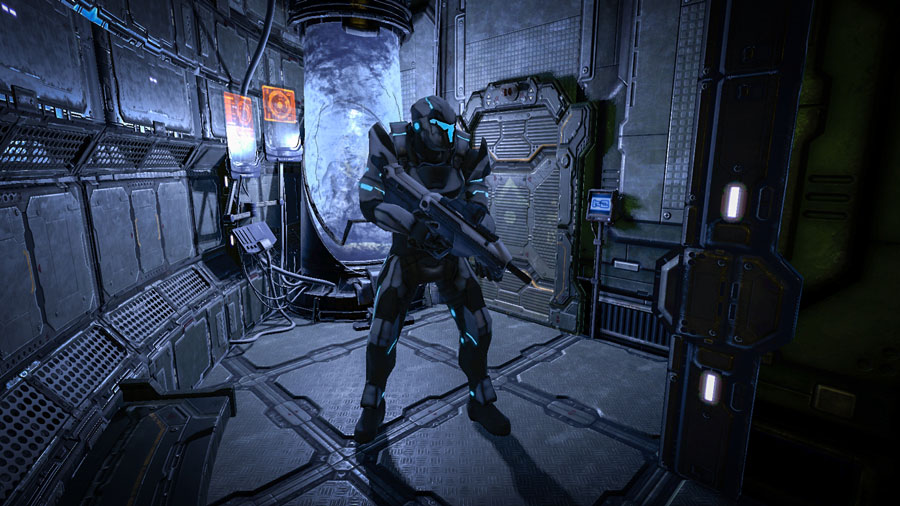
Jensen handed us our gun controllers which were, for now, modified Delta Six controls with Optitrack markers on them for tracking (the tracking on these objects proved to be much less effective than the rest of the setup but worked fine for the most part).
The portal opened up as the narrator told us our mission, we were to seek out an alien lifeform held in cryostasis, free it, stun it and bring it back to base. All in a day’s work for us space marines.
Taylor stepped through first and I followed, or at least tried to. At this point the team is still working out some of the kinks related to interaction between players in the space. I bumped into Taylor more than a couple times while trying to follow in close formation, but it wasn’t too bad or Presence breaking. As we stepped through, a horde of alien spiders crept up on us as we fired on them. I’m not a huge fan of spiders myself, so I let out a war cry as I mowed them down, their green guts splattering on the walls and on the visor of my helmet.
We turned left saw our path split in two ways in front of us, a straight corridor, and an outdoor platform. James told us to take the door to the platform and we did. As we stepped outside a number of orb shaped robotic drones with glowing white eyes began to appear in the sky in front of us. They didn’t fire on us be we sure as hell opened up on them blowing them all out of the sky. I found it surprisingly easy to aim, even from the hip (which I did a lot, for shooters in VR there is only one way to go – full Rambo).
Having cleared the drones we continued on the path, bringing us back to the other side of the corridor we saw before. Taylor exited the way we came in, on James’ direction, and we faced off in the corridor.
“Go ahead and shoot each other,” he laughed, “you can’t kill each other in this demo but you can at least get a sense for what multiplayer first person combat would be like in the Void.”
We took turns firing wildly at each other for a moment, before moving forward. Curving to the right and through a set of doors we entered the room with the cryochamber. The narrator’s voice joined us again telling us to free the alien from its chamber so we can stun it and bring it home with us. I walked up to it and as I did I felt the compressed air and mist shoot out as the alien burst free.
https://www.youtube.com/watch?v=5-HRj6jDCFM
Our guns had been set to stun and we both fired on the alien as he jumped around the room trying to get away. I finally landed the blow that stunned him and the alien slumped to the ground, motionless. I walked up and smacked it with my gun to make sure, the ragdoll effects on the model were nice as it moved when I hit it.
A door in the room opens up and we walk through it as the narrator congratulates us on a job well done before pulling us out again. Back in the white room we take off our helmets, and once again are right back in the same place we started.
Before leaving we got a chance to take a peek at a something that the team is currently working on for the Void’s launch, a port of Unreal Tournament 4. The game has been really retuned for the specific medium – you can’t be running around at 70mph through the Void, someone is going to get hurt or sick – but seems really promising. The gorgeous graphics really translate well and the nature of the physical space really suits itself for a fun first person shooter that takes Laser Quest to a whole new stratosphere.
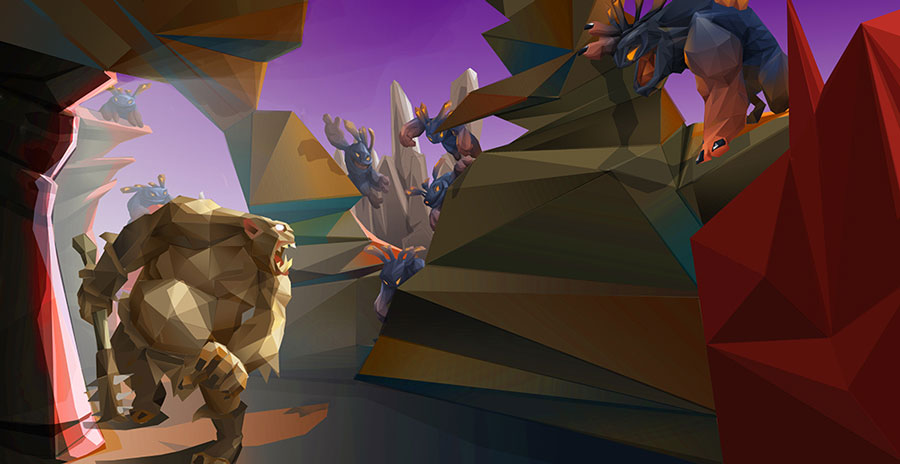
That can be said of the Void as a whole. I have had the chance to try many amazing things over the past year and the Void is by far one of the most completely immersive experiences I have had. My lizard brain was completely drawn in, and there were moments where even though I was conscious that this was a virtual environment my natural instincts took over. The Void crosses beyond Presence beckoning closer to a concept known as True Presence.
Dr. Mel Slater addresses these levels of Presence in his paper, Place Illusion and Plausibility Can Lead to Realistic Behaviour in Immersive Virtual Environments (2009). According to Slater there are two levels of immersion in VR, the first is that sense of ‘presence’ that feeling that you are in a virtual world. This is the level of immersion that we achieve in some of the best VR experiences out there, that sense where the virtual world takes over your real one. But there is a level beyond this, a level that in moments The Void managed to achieve, and that is what Slater calls the plausibility illusion or what might be more colloquially referred to as ‘true presence.’ This is when you have the impression that the situation is actually happening, so that when that elevator begins to rise you believe, even for a moment that it is truly happening.
It is still early, but the Void is already creating moments that are unforgettably immersive.
Be sure to check back this week and next as we have a lot more of the Void to share with you!

